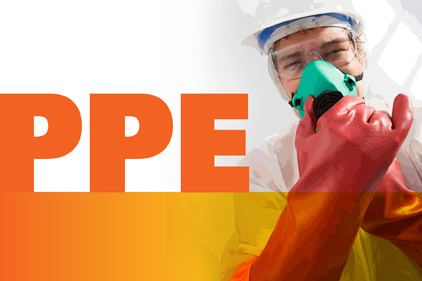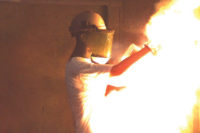 Similar but different - How to tell the difference Between Arc Rated (AR), Flash Fire Rated (FFR) and Flame Resistant (FR).
Similar but different - How to tell the difference Between Arc Rated (AR), Flash Fire Rated (FFR) and Flame Resistant (FR).
In 2012, NFPA 70E changed the terminology referencing personal protective equipment (PPE); what was formerly referred to as FR (flame resistant) clothing is to be called Arc Rated or AR, according to the standard change. The difference between the two and the reason for the change lies in the fact that ALL clothing with an arc rating (AR) is flame resistant (FR), but not all FR clothing has an arc rating. FR doesn't have any standards applying to any particular hazard. FR traditionally was believed to be generically protective from flame at some level, but this is actually untrue of some fabrics. AR indicates a garment has an arc rating and the level of protection has been determined through testing.
Ignition and insulation
The purpose of wearing flame resistant clothing is twofold, easily remembered using 'two I's': Ignition and Insulation.
First, FR PPE is worn to guard against ignition in an arc flash hazard situation. Fabrics for personal protective garments are put through a Vertical Flame Test (ASTM D6413) to measure and observe the response of materials to heat and flame under controlled conditions.
When an arc flash or flash fire-related incident ignites non-flame resistant clothing, the wearer is subject to injury from the burning or melting of the garment in addition to other injury. A garment can continue to burn, increasing the area of injury to the wearer, and can even cause internal injuries including airway and lung damage.
Wearing FR clothing reduces burn injury and restricts burns to the body surface directly related to the area of origin.
Insulation is the second function of FR clothing. Flame resistant clothing provides the wearer insulation from the higher degrees of burn (2nd and 3rd degree) through the garments and can lessen the impact on the area directly affected by the incident.
Arc rating and flame resistant are two different things but are often confused because they go together. You can't have an arc rating without the material being flame resistant. According to the arc rating standards (ASTM F1506, ASTM F1959, IEC 61482-2, IEC 61482-1-1 Method Aand IEC 61482-1-1 Method B), clothing is actually required to be flame resistant (FR) before it can even be tested to determine its arc rating.
Determining an arc rating
According to ASTM F1959, a minimum of 20 samples are required to be subjected to arc flash during testing (in reality it is usually 21 or more). Heat transfer is then measured through the fabric using sensors and is compared to the Stoll curve criteria, which determines the level of heat energy required to create a second-degree burn. Using a logistic regression, the 50% probability of reaching these criteria is calculated. (Often erroneously referred to as a 50% probability of second-degree burn, it is actually the possible onset of second-degree burn which is reached.) If holes form in the fabric before the Stoll curve is reached during testing, an EBT (Energy Breakopen Threshold) is calculated. The incident energy reached is expressed in calories per centimeter squared, the internationally accepted unit used in the original Stoll study. This number becomes the arc rating for the fabric and any garment manufactured from it. The arc rating can be reported as ATPV (Arc Thermal Performance Value) or EBT (Energy Breakopen Threshold). ATPV and EBT may both be evaluated in the same test, but the first point to be reached (the more conservative number) is reported as the arc rating.
NFPA 70E began to differentiate between FR and AR related to garments in 2012 since generic FR doesn't have specific standards applying to any particular hazard.
Flame resistant fabric had been generally thought to protect from flame but it actually is not true of some fabrics. Two problems have led to these false beliefs: old standards and small scale testing. The old standard for FR was a vertical flame test.
Developed in the 1950s when there were only two flame resistant fabric types, this method differentiated between cotton (non-FR) and aramids or treated cotton (FR). As the test became commonplace, companies found ways to "pass" the standard with cheaper but melting materials. As a result, the standards bodies developed batteries of tests which the harmful, melting materials could not pass. Unfortunately, unscrupulous manufacturers would use the old standards or parts of the new specifications to continue to sell the fake "FR". One common tactic was to use a standard like NFPA 701 (the standard for curtains and wall coverings) for clothing. This deceptive practice has hurt many workers and continues to cause companies problems in establishing specifications.
In the early 1990s large scale tests like the ASTM F1930 thermal mannequin test and the ASTM F1959arc flash test were introduced to offer "ratings" more useful than pass/fail small scale testing. These "ratings" standards provide more information for end users and incorporate hazard assessment to match the garment to the hazard. Small scale testing is certainly cost effective and still used for quality control testing, but the full scale testing now gives the ratings we use in industry for flash fire and arc flash.
Determining a Flash Fire Rating (FFR)
ASTM F1930 is a test standard for flash fire which gives a percentage body burn using a burn model (more complicated than the Stoll curve). This standard is used in NFPA 2112 and ASTM F2733 for flash fire rated garments.
These two standards have maximum levels of body burn for a specific exposure of 3 seconds at 40% (ASTM F2733) body burn and 50% (NFPA 2112) body burn for a 2 cal/cm2/s heat flux, but other burns can be specified to match the hazard your workers could face. Meeting NFPA 2112 means the garment is FFR rated at a maximum 50% body burn for this specific exposure.
Heat transmitted to each sensor location on the surface of an instrumented mannequin is converted to show the corresponding predicted degree of burn injury to human tissue. The sum of these values can then be converted to a percentage to show the total area of predicted burn injury. (from Measurement Technology Northwest)
Predicted total area of burn injury
In the flash fire testing of clothing, the sum of areas represented by the sensors that calculate at least a second degree burn injury. (from Nasco)
What to look for
It's important to read the labels of the garments and equipment before purchasing and to specify a standard to meet. Additionally, a prudent purchaser will ask for third party data on the fabrics. We recommend using ANSI 125 for PPE Conformance Compliance to specify a level of 2 or greater for compliance on most garments for arc flash and flash fire. Level 3 is normally used for firefighters' garments. These levels assure that the garments are built by a proficient manufacturer with a strong quality control process, and testing is performed by a competent lab that is independent and accredited. Appropriately labeled PPE will help direct the decision of what is best according to the designated hazard. If an arc flash hazard is apparent, the AR label should be present on any PPE. Simply selecting a garment labeled "FR" will not be sufficient protection in an arc flash situation. The arc rating will be displayed on the internal label of the garment. A flash fire garment should meet NFPA 2112 or ASTM F2733 and be appropriately labeled.
When making purchasing decisions for your workforce, keep in mind all Arc Rated and Flash Fire Rated fabrics are flame resistant, but not all FR fabrics have an appropriate rating. Be aware of companies attempting to use outdated standards (FTMS 191A.5901 or FTMS 191A.5903) or standards with no pass/fail criteria (ASTM D6413) in their testing or even standards not designed for clothing (NFPA 701). Paying careful attention to labels and testing procedures to ensure your PPE has an arc or flash fire rating will increase the level of protection you provide to your employees.
Hugh Hoagland
ArcWear Founder






